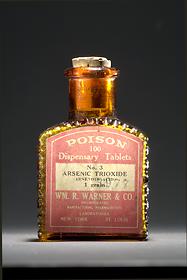Arsenic-trioxide tablets, Wm. R. Warner & Co., about 1900
Arsenic trioxide, a toxic substance employed in goldmining and other industrial processes, was also used as a medicine in the 19th and 20th centuries (it is still used today to treat leukemia and other diseases). Bottles that featured raised ridges, skulls and crossbones, and the embossed word "poison" were designed so that people could distinguish poisons from other medicines, even in the dark.
National Museum of American History, Behring Center, Smithsonian Institution
